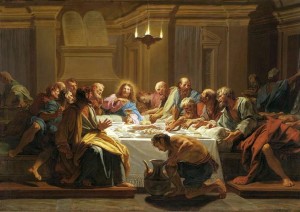A Third Question from Emily
/A Third Question from Emily
By Michael Novak at Patheos.com on April 1, 2015
EMILY: Some churches still sing Gregorian chant and perform the entire Mass in Latin, while others are singing new age music with the pop edge and giving more casual homilies in order to attract younger parishioners. Where does one draw the line between upholding tradition and changing to keep pace with the rest of the world?
GRANDPA: One imperative of the Catholic faith is to remember and be faithful to the past, and the other imperative is to look forward until the gradual unfolding of the Kingdom of God on earth moves forward another step or two; and also to look forward to the ultimate moment when “He comes again in glory.” “Do this in remembrance of me,” the Lord commends at the breaking of His body and the drinking of His blood. That’s actually what He said it was. Holding the bread, “this is my body,” He said. And “this is my blood.” On hearing those words at the Last Supper, which we commemorate on Holy Thursday tomorrow, Jesus’ closest followers took Him seriously, and they believed.
Looking backward and looking forward are two good and strong human attitudes. Jesus also used two other metaphors to express what He knew would happen to the Church. The one metaphor is of the mustard seed and the large tree that it would grow into, spreading its branches up into the sky, and getting fuller and bushier over time. The other was the small cutting from which a grapevine would grow and perhaps crawl along the ground or climb up a trellis higher and higher. He counseled cherishing the littleness of their origins, but also looking forward to their continuing and great growth and multiplication.
One other point. If a tradition is not to wither and die, it must constantly be growing. When Jesus lived and prayed, there was as yet nothing quite like Gregorian music. Only by learning from the most beautiful achievements of each generation can the Catholic tradition live and grow and fructify. To survive, a tradition must keep growing. To prosper, it must keep probing each edge for the most beautiful and enduring achievements in it.
I don’t think the issue is so much “to keep pace with the rest of the world,” as to seek out the best of what is being done in each age and to graft it onto the living vine. That is how the haunting loveliness of Gregorian chant slowly came into the patrimony of the Church, and then later polyphony, multiple voices.
Tradition is, in a sense, like a rolling snowman. Yet actually that is too inert a metaphor. New forms, new melodies, new instruments come into acts of worship steadily, are tested by a generation or two, and the best winnowed out to live for a generation, or two, or three. It is not always easy to listen to the new (and to put up with its faults and limitations when compared with the achievements of the past), but if the tradition is to be kept alive and to grow, each generation must be open to its own genius.


